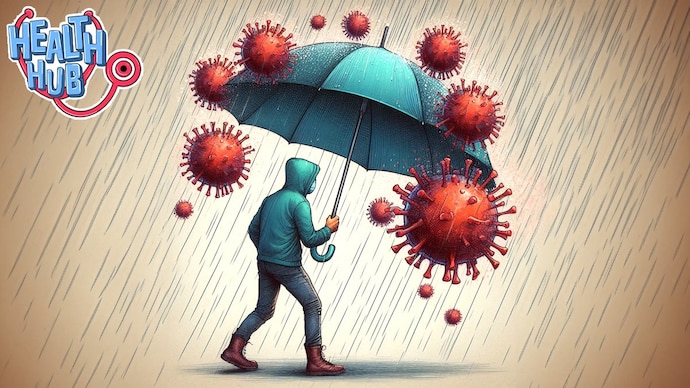Why is monsoon a harbinger of brain-infecting germs?
The monsoon season in India sees a rise in infectious diseases, with humidity and waterlogging creating ideal conditions for germs to thrive, particularly affecting children and the elderly.

Every year, a slew of infectious diseases surge during the monsoon. Humidity, waterlogging and moist air create ideal conditions for germs to thrive and cause serious health complications in vulnerable populations like children and the elderly.
Chandipura virus in Gujarat, Nipah virus and the amoebic infection Naegleria fowleri in Kerala, swine flu in Mumbai, Zika virus in Maharashtra and Karnataka, and then the usual dengue and malaria spreading in different regions: this is the status report of monsoon-related diseases in India this year.
And this is just the tip of the iceberg.
Various types of bacterial infections causing headaches and migraines, diarrhoea due to stomach infections, elephantiasis, leptospirosis, pneumonia, tuberculosis, sinusitis, meningitis and many other diseases have been reported in the country.
What most infections have in common is how they cause neurological complications. Understanding these microbes and how they infect the brain can increase awareness about public health, prevention, and surveillance.
Humidity and microbial growth
The monsoon season often acts as a harbinger for microbes infecting the brain, as several environmental and behavioural factors come together during this period.
Heavy rainfall and increased humidity create ideal conditions for the growth and spread of various microorganisms, including bacteria, viruses and amoeba, which can cause serious infections.
One of the major reasons for the increased risk of brain infection is the accumulation of stagnant water.
Heavy rainfall during this season often results in the formation of puddles, pools and other stagnant water bodies, which become breeding grounds for germs.
For example, the amoeba Naegleria fowleri, which can cause a rare but fatal brain infection called primary amebic meningoencephalitis (PAM), thrives in the warm freshwater environments that are common during the monsoon.
When this amoeba enters the body, it reaches the brain and causes confusion, behavioral changes, seizures, coma and even death. This year, three children died of PAM in Kerala.
Brain infections increase during monsoon
Cases of brain infections increase in the coastal and rice belt areas of India during the monsoon. High humidity and increased mosquito breeding in these areas lead to viral encephalitis and other brain infections.
These brain infections cause symptoms such as fever, headache, vomiting, seizures and changes in consciousness.
Encephalitis, a brain infection, occurs when the brain becomes inflamed due to infection with bacteria, viruses, fungi, or parasites. These infections can cause severe inflammation and damage to brain tissue, potentially leading to a number of neurological symptoms.
The incidence of brain infections increases during the monsoon season as conditions are favourable for the breeding of mosquitoes, which are carriers of several viral infections like dengue and Japanese encephalitis.
Coastal regions such as Karnataka and Orissa, northeastern states such as Assam and Tripura, and rice-producing northern states such as Bihar and Uttar Pradesh are endemic areas for viral encephalitis in India.
“Encephalitis was first clinically diagnosed in 1955 in the coastal areas and rice belt population. The disease is endemic in 171 districts across 19 states,” said Dr Sunil Singla, director and head of the department of neurology at Shalby Sanar International Hospital, Gurugram.
Brain infections can be of many types – viral, bacterial, tubercular, fungal or protozoal. The most common symptoms of brain infections include fever, headache, vomiting, seizures and changes in consciousness.
Dr Sanjay Pandey, head of the department of neurology and stroke medicine at Amrita Hospital, Faridabad, said, “Children and senior citizens are more susceptible to such infections as their immunity is weak. Parents should be alert to symptoms like rashes and fainting in their children during this season.”
According to Dr S Narendran, consultant neurologist at Meenakshi Mission Hospital and Research Centre, Madurai, since rice fields attract rats, most people arrive at the outpatient department (OPD) with various infections like leptospirosis.
According to a study published in the ICMR journal, encephalitis was first clinically diagnosed in 1955 in populations of coastal areas and rice belts.
The disease is endemic in 171 districts in 19 states. Deaths were reported to the National Vector Borne Disease Control Programme (NVBDCP), with the case fatality rate being very high.
The affected states include Tamil Nadu and Uttar Pradesh, followed by West Bengal, Assam and Bihar.
“Sudden onset of tooth cramps and altered level of consciousness, which mostly occurs in the morning, are common symptoms of encephalitis. Patients also experience symptoms such as fever, headache, muscle weakness, coordination problems, disorientation, mental confusion, increased sensitivity to light, seizures and fatigue,” Dr Singla said.
Doctors suggest that early intervention is key to effectively manage these infections and improve patient outcomes.
“Preventing mosquito breeding and avoiding mosquito bites are essential steps. If not treated timely, diseases like viral encephalitis can pave the way for parkinsonism, dystonia and tremors,” cautioned Dr Pandey.
How to stop this?
Although the monsoon is essential for sustaining agriculture and livelihoods in coastal and rice-producing regions, its potential impact on public health highlights the importance of proactive measures to protect vulnerable populations.
Dr Deepak Yadav, Neurology Consultant, Amrita Hospital, Faridabad, said, “Effective public health strategies, including awareness campaigns and prompt medical intervention, are crucial in preventing outbreaks of brain infections and other waterborne diseases.”
Preventive measures are important during monsoon to reduce the risk of germs infecting the brain.
These measures include avoiding swimming in stagnant or potentially contaminated water, using nose clips to prevent water from entering the nasal passages, ensuring proper cleaning and hygiene, and treating water sources to eliminate harmful microorganisms.
Despite these precautions, the unique environmental conditions of the monsoon season significantly increase the risk of exposure to brain-infecting pathogens, highlighting the need to raise awareness and take preventive actions at this time.






